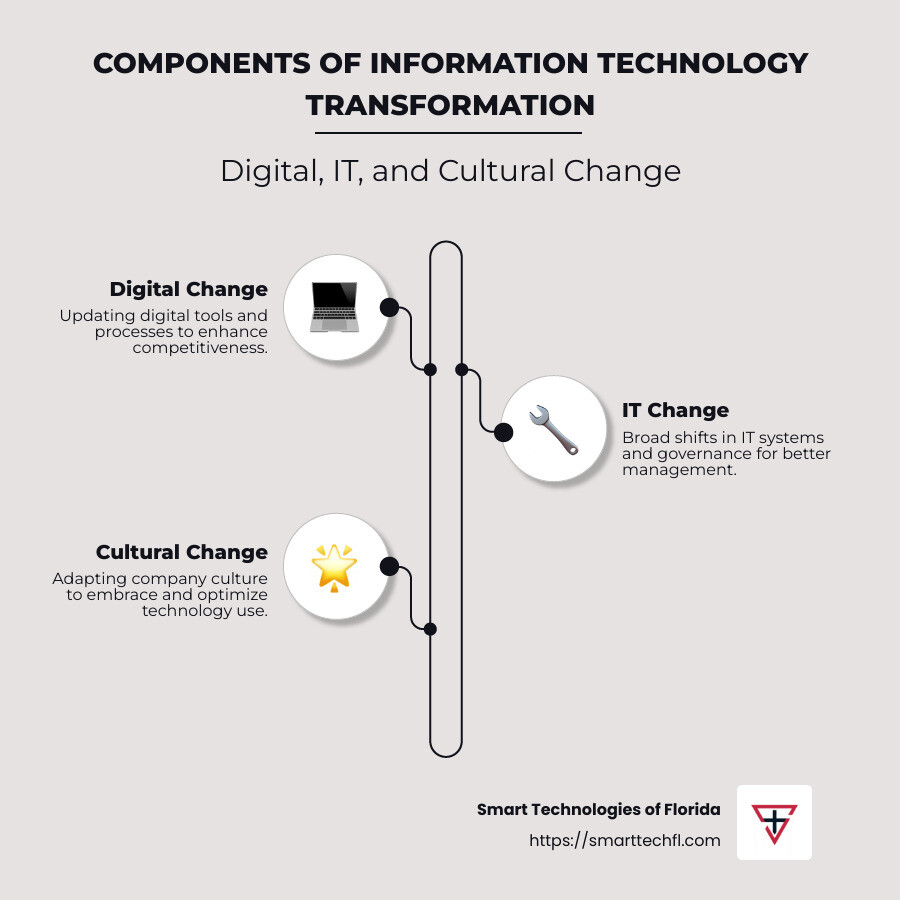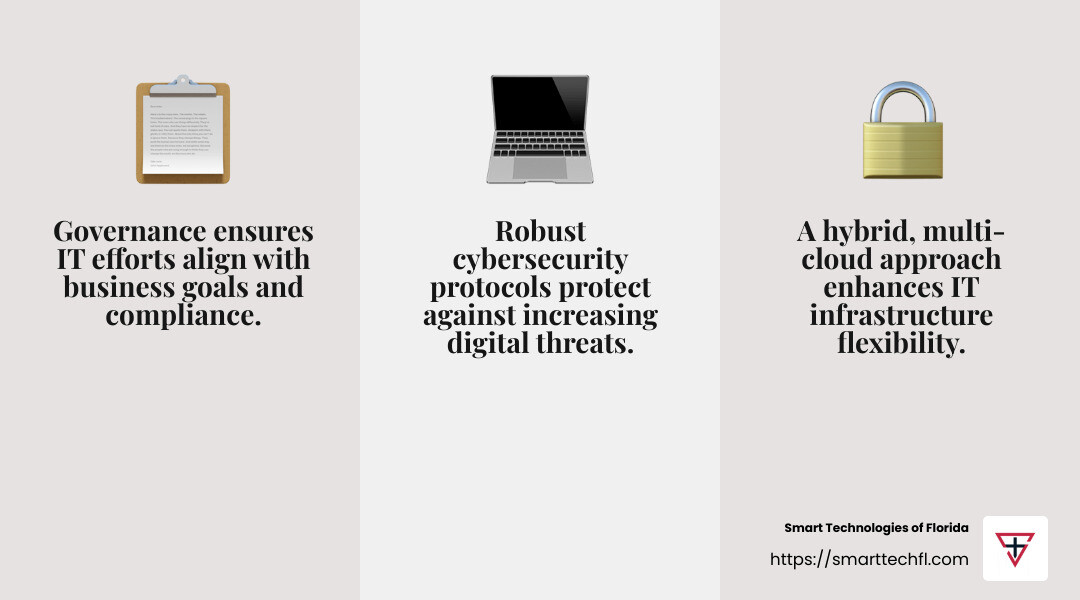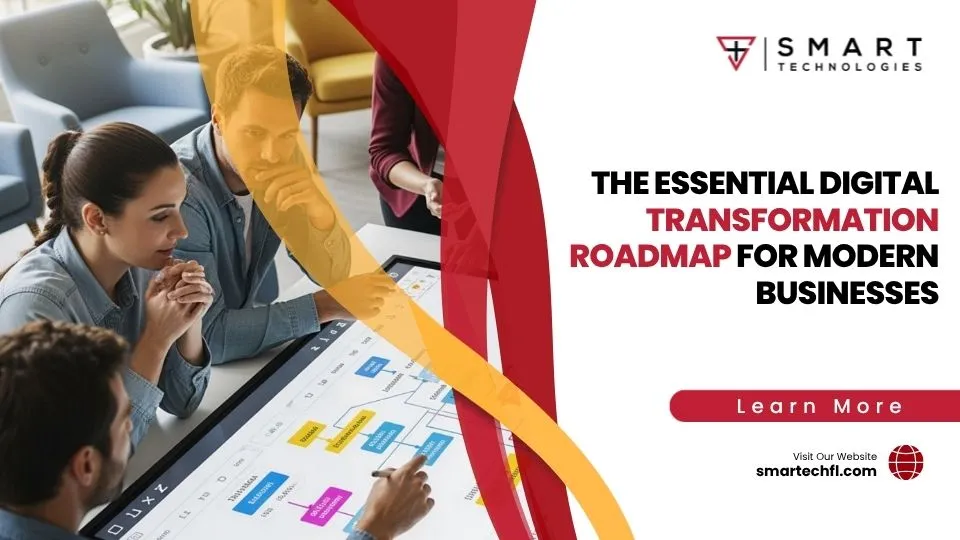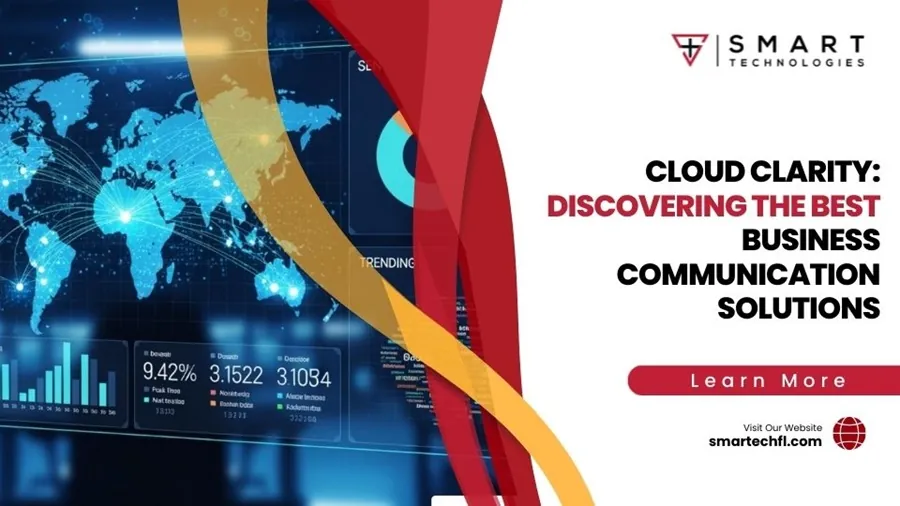From Analog to Digital: Understanding Information Technology Transformation
Information Technology Change is a comprehensive reassessment of how businesses use technology to operate and compete in the digital economy. It’s not just about upgrading software or hardware. It’s about rethinking entire IT systems and how they fit into the broader business strategy.

Complete Reassessment
The first step in IT change is a complete reassessment of existing systems. This means evaluating everything from data storage solutions to cybersecurity protocols. Businesses need to identify what works, what doesn’t, and what needs to be improved.
For example, the chaos experienced by Southwest Airlines during a holiday season, where over 15,000 flights were canceled, highlights the risks of outdated systems. Their decade-old scheduling software couldn’t handle the demands, leading to significant financial losses and damaged customer trust. This underscores the importance of regularly reassessing and updating IT systems to meet current and future needs.
IT Systems
Modern IT systems are at the heart of any successful business operation. They include everything from cloud computing to AI-driven analytics. These systems help companies gather data, automate processes, and make informed decisions.
For instance, many startups today are leveraging cloud-based solutions instead of traditional, large-scale software packages. According to Bryson Koehler, CTO of Equifax, innovation thrives when companies build new capabilities rather than relying on existing packaged solutions. This mindset is crucial for fostering innovation and agility within an organization.
Digital Economy
In the digital economy, businesses must adapt to rapidly changing technologies and customer expectations. This requires a shift from simply running IT operations to using technology as a strategic asset.
Organizations are increasingly using digital tools to improve customer experiences, streamline operations, and create new business models. A McKinsey report emphasizes that digital change is about continuous adaptation. It’s a long-term journey, not a one-time project.
In conclusion, Information Technology Change is about aligning IT systems with business goals to thrive in the digital economy. It’s a strategic move that involves reassessing current technologies, embracing new tools, and continuously evolving to meet market demands. This change is essential for businesses to remain competitive and relevant in today’s world.
Key Components of IT Change
When it comes to Information Technology Change, there are three critical components: governance, IT infrastructure, and cybersecurity. Each plays a vital role in ensuring a successful transition from analog to digital.
Governance
Governance is the backbone of any IT change. It involves setting up policies and frameworks to manage IT resources effectively. Think of it as the rulebook that guides how technology decisions are made and how resources are allocated.
Without proper governance, IT projects can become chaotic. Clear governance helps ensure that IT efforts align with business goals and regulatory requirements. For example, integrating risk checks into the development process can help address concerns like data privacy and cybersecurity, which are crucial in today’s digital landscape.
IT Infrastructure
Next up is IT Infrastructure. This is the hardware and software foundation that supports all technology operations. It includes servers, networks, and data centers. Upgrading IT infrastructure is often necessary to support new digital initiatives.
A hybrid, multi-cloud approach is gaining popularity. This strategy combines private and public cloud resources to create a flexible and scalable IT environment. By leveraging both types of clouds, businesses can manage seasonal spikes and maintain service-level agreements (SLAs) efficiently.
Cybersecurity
Lastly, Cybersecurity is non-negotiable in IT change. As businesses become more digital, the risk of cyber threats increases. Protecting sensitive data and ensuring privacy are paramount.
Effective cybersecurity measures include robust protocols and regular assessments to identify vulnerabilities. Companies must be proactive in managing these risks to prevent data breaches and maintain customer trust.

These three components—governance, IT infrastructure, and cybersecurity—are essential for a successful IT change. They ensure that technology changes are well-managed, secure, and aligned with business objectives. By focusing on these areas, organizations can steer the complexities of digital change and emerge stronger in the digital economy.
The Role of Culture in IT Change
When we talk about Information Technology Change, it’s not just about tech and systems. It’s also about people and culture.
Leadership
Leadership is crucial in IT change. Leaders set the tone and direction for the entire organization. They need to be champions of change, showing everyone why it’s important. Bryson Koehler, CTO of Equifax, highlights this shift by saying, “You’re not here to run the mainframe anymore.” Leaders must inspire teams to build new capabilities and accept innovation.
Strong leadership helps create a vision that motivates everyone. It encourages teams to move beyond traditional roles and think creatively. This is essential for a successful change.
Cultural Change
Cultural change is often the hardest part of IT change. It involves changing the way people think and work. This means breaking down silos and encouraging collaboration across departments. Digital changes often reshape workgroups and processes. People need to feel safe and valued during these changes.
It’s important to communicate clearly and openly. Show employees the benefits of change and celebrate early wins. This helps reduce fear and resistance.
People-Centric Approach
A people-centric approach puts employees and customers at the heart of IT change. After all, technology is only as good as the people who use it. Focusing on user experiences can lead to better adoption and satisfaction.
Organizations should support employees with training and tools that make their jobs easier. Performance support tools like digital adoption platforms can help employees learn new systems quickly. This reduces frustration and boosts productivity.
By prioritizing people and culture, companies can ensure that their IT change is not just about technology but about creating a better workplace for everyone. This approach leads to more engaged employees and happier customers, paving the way for long-term success.
Benefits of Information Technology Change
Information technology change brings a host of benefits that can propel a business forward. Let’s explore three key advantages: operational efficiency, customer experience, and cost management.
Operational Efficiency
Changing IT systems can significantly boost operational efficiency. By updating old systems and processes, businesses can streamline their operations. This means tasks get done faster and with fewer errors.
For instance, automating routine tasks can free up employees to focus on more important work. A report from McKinsey found that companies adopting digital solutions often see productivity improvements. High-performing teams can be up to five times more productive than their less efficient counterparts.
Customer Experience
A better customer experience is another major benefit of IT change. Today’s customers expect seamless interactions across multiple platforms like mobile apps, social media, and live chat.
Digital changes allow businesses to meet these expectations by offering improved services. For example, using AI in customer service can help manage inquiries more efficiently, leading to quicker resolutions and happier customers. Companies like Amazon have set the standard by continuously investing in technology to improve customer interactions.
Cost Management
Finally, information technology change can lead to significant cost savings. By optimizing resources and reducing waste, businesses can lower their operational expenses.
Consultants often help companies identify areas where technology can cut costs. Whether it’s through automating processes or migrating to the cloud, these changes can lead to substantial savings. A study highlighted that businesses could see a quick return on investment by managing IT costs effectively.
In summary, embracing IT change can transform a business. It improves efficiency, delights customers, and manages costs, setting the stage for future growth. Now, let’s explore the steps to implement IT change effectively.
Steps to Implement IT Change
Implementing information technology change can seem daunting, but breaking it down into clear steps makes it manageable. Here’s a simple guide to help steer the process.
Strategy Development
The first step is to develop a solid strategy. This means aligning IT goals with business objectives. Start by defining what you want to achieve. Is it better customer service, reduced costs, or increased agility?
Involve leaders from different departments to ensure everyone is on the same page. This collaborative approach can help avoid focusing solely on technology problems and instead address broader business issues. According to McKinsey, successful changes are tied closely to business value and strategy.
Infrastructure Upgrades
Next, look at your current IT infrastructure. What needs upgrading to support your new goals? This often includes moving to a hybrid, multi-cloud approach. Combining private and public cloud resources can offer flexibility and help manage seasonal spikes in demand.
For example, Intel suggests upgrading to the latest processors and adding solid-state drives to overcome network bottlenecks. This ensures your systems run smoothly and efficiently.
Change Management
Change management is crucial. It’s not just about technology; it’s about people. To succeed, you need buy-in from both executives and employees. Communicate the benefits clearly and regularly. Use proven change management models to guide the process.
Regular conversations with employees can help address concerns and build trust. According to research, fostering a culture that supports change is key to change success.
By following these steps—strategy development, infrastructure upgrades, and effective change management—you can implement IT change smoothly and set your business up for success. Now, let’s move on to some frequently asked questions about IT change.
Frequently Asked Questions about Information Technology Change
What is the IT change strategy?
An IT change strategy is a structured plan that aligns technology initiatives with business goals. It’s about defining clear objectives, such as enhancing customer service or reducing costs, and then mapping out the steps to achieve them. Successful IT change strategies focus on generating a return on investment (ROI) by ensuring that every tech upgrade or process change directly benefits the business.
One key aspect is alignment. This means getting input from leaders across various departments to ensure everyone is working towards the same goals. As McKinsey notes, aligning IT with business strategy is crucial for open uping business value.
What are the three pillars of IT change?
There are three main pillars that support successful information technology change: governance, IT infrastructure, and cybersecurity.
- Governance: This involves setting up rules and processes to manage IT resources effectively. Good governance ensures that technology investments align with business objectives and comply with regulations.
- IT Infrastructure: This includes the hardware and software that form the backbone of your IT systems. Upgrading to a hybrid, multi-cloud infrastructure can provide the flexibility needed to adapt to changing demands and improve performance.
- Cybersecurity: Protecting data and systems from cyber threats is more important than ever. A strong cybersecurity strategy involves regular assessments and updates to guard against new risks.
How has the COVID-19 pandemic changed digital change?
The COVID-19 pandemic has significantly accelerated digital change. It pushed organizations to adopt remote work models quickly, which required rapid experimentation with new tools and technologies.
This shift led to a reevaluation of customer expectations. Businesses had to find new ways to engage with customers online, leading to innovations in digital services and products. According to Swift, the crisis helped organizations accept the idea that “the perfect is the enemy of the good,” encouraging them to prioritize working solutions over perfect ones.
The pandemic also highlighted the importance of agility. Companies that could quickly adapt to new challenges were better positioned to thrive. This experience underscored the need for flexible IT infrastructures and robust change management practices to support ongoing change efforts.
By understanding these aspects of IT change, businesses can better steer the complexities of digital change.
Conclusion
At Smart Technologies of Florida, we believe that information technology change is not just about upgrading systems—it’s about strategic change that aligns with your unique goals. With 23 years of experience, we’ve seen how custom digital solutions can empower businesses to thrive in the digital age.
Strategic Change: We focus on more than just technology. Our approach is holistic, integrating IT change with your business strategy. This ensures that every tech upgrade serves a purpose and adds value. As McKinsey highlights, aligning IT with business goals is crucial for success.
Custom Digital Solutions: Every business is unique, and so are its challenges. That’s why we tailor our solutions to fit your specific needs. Whether it’s enhancing customer experience, improving operational efficiency, or managing costs, our people-centric approach ensures that your change journey is smooth and effective.
In today’s digital economy, staying ahead requires continuous adaptation and innovation. By partnering with us, you’re not just upgrading technology—you’re evolving your entire business model to meet the demands of tomorrow.
For more on how we can help with your business process automation, check out our Business Process Automation Solutions.
Together, let’s transform your business and open up its full potential.












